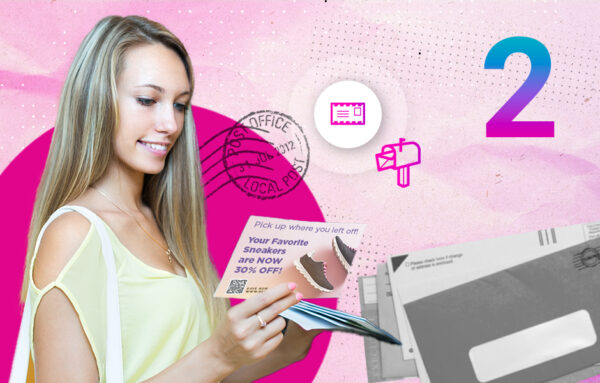
By Tim Moran VP, Brand, Printing for Less
Part 1 of this series about “The Power of Direct Mail” explored the five main kinds of direct mail marketing as well as why it remains one of the most effective ways to reach your audience. In an age where digital marketing dominates to the extent that people are fatigued by digital engagement methods, it’s almost impossible to gain anyone’s attention. That’s why, today, businesses have an engagement problem, not a reach problem. It’s also why businesses of all sizes in many industries are turning to direct mail programs as part of their marketing mix. With direct mail, brands can deliver one-to-one personalization with direct mail— no matter the physical nature of the items (flat or dimensional), no matter who the sender, no matter who the recipient.
Among the more popular and robust direct mail pieces are postcards, which offer a refreshing and effective way to engage with your audience. Whether you’re a marketing professional in an enterprise, a small business owner, a real estate agent, or a landscaper, postcards can enhance your promotional strategies. Here’s a look at some of the most common types of direct mail postcards, their benefits, and how to integrate them with digital marketing to achieve your goals.
Standard Postcards for Quick Impact
Standard postcards come in a variety of sizes: 4.25″ x 5.5″, 4″ x 6″, 5″ x 7″, 5.5″ x 8.5″, 6″ x 9″, and 6″ x 11″. Many find 4” x 6” to be the most cost-effective of them all. They are perfect for making a quick impact with a clear and concise message. Their smaller size ensures that they are easy to handle and inexpensive to produce and mail. They are ideal for announcing sales, coupons, special events, or new product launches.
Deluxe and Oversized Postcards for Maximum Visibility
For campaigns that require a bit more visibility and attention, deluxe and oversized postcards are always a good choice. These postcards—ranging in size from 5” x 7” to 6” x 11” or even larger—stand out in a crowded mailbox. Their larger size provides more space for graphics and detailed information, making them perfect for showcasing high-quality images, real estate listings, or other detailed service offerings. They also tend to have a higher perceived value, which can enhance the recipient’s opinion of your business and engagement with your message.
Creative Design Tips
No matter the shape or size, creating an eye-catching postcard involves more than just words with a compelling offer. Here are some tips to ensure that your postcards stand out:
- Bold Headlines: Capture attention with a bold, concise headline that conveys your main message instantly.
- High-Quality Images: Use high-resolution images that are relevant and appealing to your target audience.
- Clear Call to Action (CTA): Make sure your call to action (CTA) is understandable and prominently placed. Whether it’s to visit a website, call a number, or visit a brick-and-mortar store or restaurant, the CTA should be easy to find and act upon.
- Minimalist Design: Avoid clutter. A clean design helps focus the recipient’s attention on your key message and CTA.
- Brand Consistency: Ensure that your postcard design is consistent with your overall brand identity, including colors, fonts, and logo placement.
Pairing Postcards with Digital Strategies
No marketer believes that direct mail postcards, alone, are all you need to support your business. It’s imperative to maximize the impact of your direct mail campaigns by integrating it with your other digital marketing strategies in these ways:
- QR Codes and PURLs: Include QR codes or personalized URLs (PURLs) that direct recipients to a specific landing page. This not only makes it easier for recipients to respond, but also allows you to track engagement.
- Social Media Integration: Encourage recipients to follow your social media accounts for exclusive deals or additional content. You can also use postcards to promote social media contests or campaigns.
- Email Follow-ups: Use your direct mail campaign as a trigger for email follow-ups. For example, if a recipient hasn’t responded to your postcard offer, send a reminder email with additional incentives.
- Omnichannel Tracking: Use tools to track how recipients interact with your postcard and follow up through other channels accordingly. This can include retargeting ads based on who has scanned a QR code or visited a landing page.
Personalization Capabilities of Postcards
One of the greatest strengths of direct mail postcards is that they can be personalized to include the recipient’s name, address, and even content based on their past interactions or preferences. This level of customization can significantly increase engagement and conversion rates. Variable data printing (VDP) technology allows you to create highly personalized postcards at scale, making each recipient feel valued and special.
Measuring Success
To ensure your direct mail postcard campaigns are effective, it’s essential to measure their success. Here are some ways to do it:
- Response Rate: Track how many recipients responded to your postcard offer. This can be done through QR codes, PURLs, or specific phone numbers.
- Conversion Rate: Measure how many of those responses led to a sale or desired action.
- Return on Investment (ROI): Calculate the ROI by comparing the revenue generated from the campaign to the costs of producing and mailing the postcards.
- A/B Testing: Experiment with different designs, messages, and offers to see what resonates best with your audience. Use the results to refine future campaigns.
Direct mail postcards are a versatile and powerful tool for enhancing your marketing strategy. By understanding the different types of postcards, leveraging creative design tips, integrating with digital strategies, and measuring success, you can create effective campaigns that capture attention and drive results. Let Printing for Less help you create postcards and marketing that will connect you with your audience in a tangible and memorable way.
